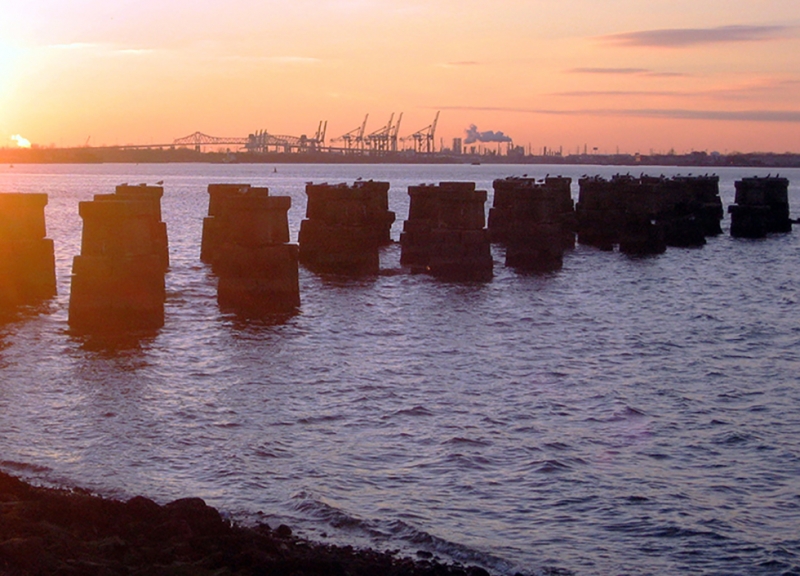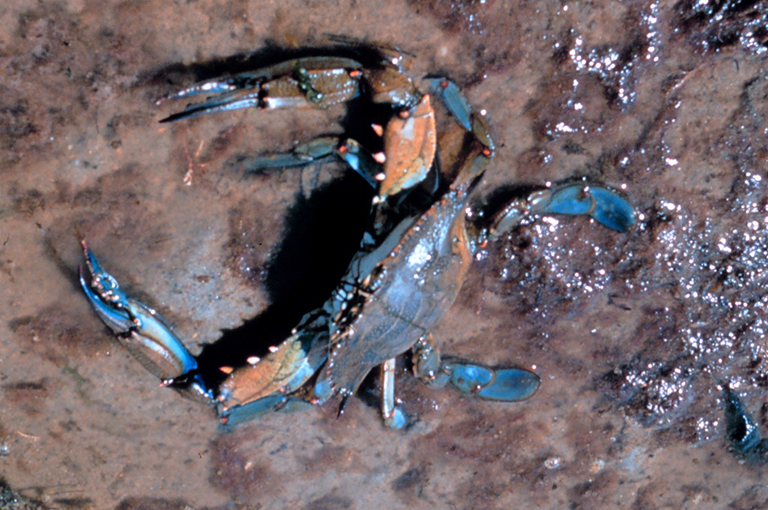This week, NOAA’s Office of Response and Restoration is looking at the impacts of pollutants on wildlife and endangered species. We’ll explore tools we’ve developed to map sensitive species and habitats, how marine debris endangers marine life, how restoring toxic waste sites improves the health of wildlife, and the creation of a mobile wildlife hospital.

Northern New Jersey’s industrial history continues to effect two popular recreational fisheries, striped bass and blue crab. Examining how toxic waste from the past continues to impact people and wildlife today shows the importance of continuing to cleanup and restore polluted habitats.
Striped Bass
Striped bass is prized both for its taste and for the challenge in catching the fish. Its popularity in sports fishing circles rivals that of salmon. Yet because of pollutants found in the fish, the New Jersey Department of Environmental Protection cautions people to limit their consumption of striped bass caught in the state and advises high-risk individuals—including children—not to eat them at all. For striped bass caught in some of the northern parts of the State, like in the Newark Bay Complex – the bay and its tidal tributaries – the department has even stricter recommendations for limiting consumption.
Since the beginning of the twentieth century, the northeastern part of our country was heavily industrialized. Plastics, dyes, pharmaceuticals, and paint are just a few examples of important manufacturing that took place in these areas and that released, as by-products, toxic substances such as mercury, chromium, arsenic, lead, and PCBs into local bodies of water.

Because striped bass move inland to spawn, they are accessible to recreational fishers but exposed to the contaminated sediments that remain in some of these areas from their industrial history. Striped bass is a long-lived predatory fish that feeds on smaller fish, so bioaccumulative contaminants (like mercury and PCBs) can build up in its tissues. These contaminants are harmful to people who consume the fish and are unhealthy for the fish themselves.
Blue Crab
Found in brackish estuarine areas in the same region are blue crabs. Blue crabs are among the most sought-after shellfish—both commercially and recreationally—and are found from Nova Scotia to Uruguay. Callinectes sapidus, the Latin name for blue crab, means “savory beautiful swimmer.” At about 4 inches long and 9 inches wide, they are prized for their taste.
The New Jersey Department of Environmental Protection warns that:
“…blue claw crabs from the Newark Bay region are contaminated with harmful levels of dioxin and polychlorinated biphenyls (PCBs). Eating blue claw crabs from this region may cause cancer and harm brain development in unborn and young children. Fish consumption advisories in this region for blue claw crabs are DO NOT CATCH! AND DO NOT EAT!”

Blue crab serve an important role in the ecosystem as benthic (bottom) feeders and important prey for other fish. But because they live at the bottom of waterways, those found in formerly industrial areas, can be in direct contact with contaminated sediments that are the legacy of the historical discharge of industrial wastes and these contaminants can accumulate in their bodies. In addition to making the blue crab unsuitable for human consumption, those toxins adversely affect the blue crabs themselves, negatively impacting their survival, growth, or reproduction.
Restoring Clean and Healthy Habitats
The good news is that the process of cleanup and restoration is in progress at many of these contaminated waste sites in northern New Jersey including Newark Bay as well as throughout the country.
The industries that contributed to the pollution were developing products we depend on and were bolstering the nation’s economy but it is also essential to rehabilitate contaminated waterways and restore the habitats on which these species depend.
The Comprehensive Environmental Response, Compensation, and Liability Act of 1980, commonly known as Superfund, guides the reduction of exposure of wildlife like striped bass and blue crab to contaminated areas and enables the Trustees, including NOAA, to recover the costs of restoring or replacing the equivalent of the resources that the public has lost because of the contamination.
The Trustees work to ensure that the cleanups minimize ongoing injury to wildlife and the people who use those resources. Trustees also restore clean healthy habitats for fish and shellfish to compensate for the lost use of areas that were contaminated; restored areas are designed to improve fish and shellfish populations and enhance recreational access.
For more information on our restoration work in New Jersey, read the following articles:
- Restoration on the Way for New Jersey’s Raritan River, Long Polluted by Industrial Waste
- How Do You Begin to Clean up a Century of Pollution on New Jersey’s Passaic River?
- Working to Reverse the Legacy of Lead in New Jersey’s Raritan Bay
Read more stories in our series on the effects of pollutants on wildlife:
- How to Locate Wildlife Threatened During Oil Spills
- How Marine Debris is Impacting Marine Animals
- Oils Spills and Animal Rescue in Alaska and Beyond
Reyhan Mehran, NOAA Regional Resource Coordinator with the Assessment and Restoration Division, and Vicki Loe, Communications Coordinator for NOAA’s Office of Response and Restoration, contributed to this article.
